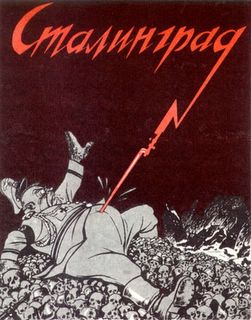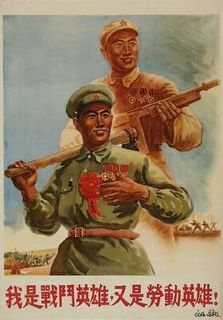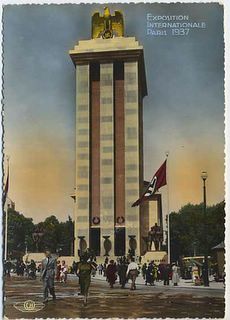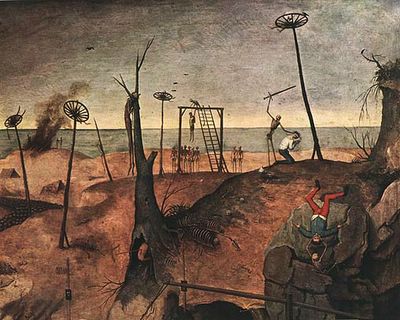Thursday, February 1, 2007
A brief analysis of propaganda
1- The term propaganda comes from the title and work of the Congregatio de Propaganda Fide (Congregation for Propagation of the Faith), an organization of Roman Catholic cardinals founded in 1622 to carry on missionary work. 2- Propaganda also means agitation. Elaborating upon Lenin's pamphlet What Is To Be Done? Russian Marxist Georgy Plekhanov defined propaganda as “the reasoned use of historical and scientific arguments to indoctrinate the educated and enlightened.” He defined agitation as the use of "slogans, parables, and half-truths to exploit the grievances of the uneducated and the unreasonable." He regarded both strategies as absolutely essential to political victory and twinned them in the term agitprop. 3- This is how Joseph Goebbels (Hitler's minister of Propaganda) understood it: "Political propaganda in principle is active and revolutionary. It is aimed at the broad masses. It speaks the language of the people because it wants to be understood by the people. Its task is the highest creative art of putting sometimes complicated events and facts in a way simple enough to be understood by the man on the street. Its foundation is that there is nothing the people cannot understand, but rather things must be put in a way that they can understand. It is a question of making it clear to him by using the proper approach, evidence, and language." 4- Propaganda manipulates other people's beliefs, attitudes, or actions by means of symbols: Words, gestures, banners, monuments, music, clothing, insignia, hairstyles, designs on coins and postage stamps, and so forth. 5- At the level of symbols: Gestures (a military salute); postures (a weary slump, folded arms, a sit-down, an aristocratic bearing); structures (a monument, a building); items of clothing (a uniform, a civilian suit); visual signs (a poster, a flag, a picket sign, a badge, a printed page, a commemorative postage stamp, a swastika scrawled on a wall); all these constitute instances of propaganda. 6- Contemporary propaganda employs elaborate social-scientific research facilities to conduct opinion surveys and psychological interviews in efforts to learn the symbolic meanings of given signs. Written media include letters, handbills, posters, billboards, newspapers, magazines, books, and handwriting on walls and streets. Among audiovisual media, TV is the most powerful. 7- Although propaganda and advertising share a number of strategies, I prefer not to overlap them. Advertising includes all forms of paid, nonpersonal communication and promotion of products, services, or ideas by a specified sponsor. It appears in print media (newspapers, magazines, billboards, flyers) or broadcast (radio, TV). We'll tackle the issue later on in the semester.

El Guerrillero Heroico (Cuba, 1969). The image of El Che (the Argentinian guerilla fighter who died in the jungles of Bolivia) is one of the most important icons of late Twentieth Century propaganda.

The Islamic Revolution (early 1980's). A typical gesture of the Iranian poster after the revolution, the clenched fist rises up directly out of the people.

Stalingrad! (1943) The poster illustrates the defeat of the Germans at the Battle of Stalingrad, a turning point in the German war in the easter front.

Chinese posters served to inform of Land Reform policies and to publicize new rules and regulations, such as the Marriage Law; rectification movements of intellectuals; campaigns to weed out corruption, bureaucratism and petty crime; and movements to boost popular support for the new regime, in particular in the cities. All the people were mobilized to help reconstruct the country in whatever manner possible (see how important the color red is).

Soviet pavillion (Paris Expo, 1937) Boris Iofan, architect. Of course, Iofan is no Speer. The similarity between the two monuments has to do with how Neo-Classicism becomes a style that can easily define totalitarian regimes. Stalin's love for Neo-Classical architecture (see this link) harks back to (irony of ironies!) a New York building designed by McKim, Mead & White.

We Can Do It. An American poster by J. Howard Miller (circa 1944). From 1941-45, women were asked to join forces for the war effort. They proved to be as efficient as men at working in the factories. This poster hints at equality: A young woman wearing a factory uniform, rolls up her sleeves while flexing her biceps -a typical male gesture of vigor.

German Pavillion (Paris Expo, 1937). Albert Speer, architect. Even in spite of its short reign (1933-1945) was there a Nazi architecture?
This clip is taken from Leni Riefenstahl's famous propaganda movie "Triumph des Willens" (1935). French writer Georges Bataille wrote about the "aesthetic power" of these highly manipulated Nazi public demonstrations, which appeared as sacred symbols (one can tell the amount of detailed planning of choreography and mis-en-scene behind them). Hitler would say: "The receptive powers of the masses are very limited, and their understanding is feeble. All effective propaganda must be confined to a few bare essentials and these must be expressed as far as possible in stereotyped formulas. These slogans should be persistently repeated until the very last individual has come to grasp the idea that has been put forward…" (Doesn't it sound a bit like modern advertisement?). Trumph of the Will is widely regarded as one of the most effective pieces of propaganda ever produced. A masterful, epic, innovative work of documentary filmmaking, commissioned by the Nazi party and widely used to support Hitler's cause before the war. The film was a rousing success in Europe, but widely banned in America.

Lenin was, Lenin is, Lenin will live! (Soviet poster, 1940's). Lenin is the father of the Bolshevik Revolution. This poster uses his image to legitimize the Soviet offensive against the Germans under the Stalin regime.

Nazi propaganda before 1933. A tied-up Nazi watches while a Jew reading the Berliner Tageblatt, which the Nazis accused of being a Jewish paper, mistreats a Germany chained to the Treaty of Versailles. The Jew is probably supposed to be a journalist, since he is smearing Gemany with his pen. A Black French colonial soldier and another figure (either a policeman or a Polish soldier) assist.
An early form of propaganda
 Napoleon Crossing the Alps (by Jacques-Louis David). This epic painting is a form of early propaganda. With it, David idealized and legitimized Napoleon's Italian Campaign of 1796. After Napoleon's fall, David's work lost its social and political influence.
Napoleon Crossing the Alps (by Jacques-Louis David). This epic painting is a form of early propaganda. With it, David idealized and legitimized Napoleon's Italian Campaign of 1796. After Napoleon's fall, David's work lost its social and political influence.

Peter Brueghel's Triumph of Death. According to 15th Century Treatise Ars Memorandi, "If you want to educate with images, choose the most frightful ones."
Subscribe to:
Comments (Atom)
